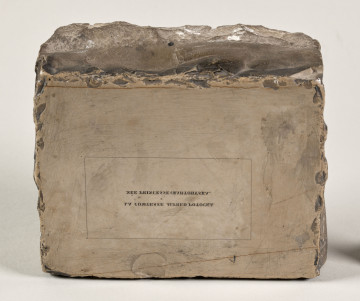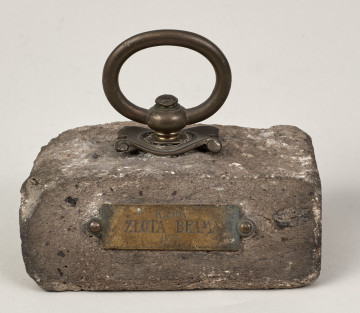
Paperweight
XIX century
Castle Museum in Łańcut
Part of the collection: Broń, instrumenty, varia
All you need to write is a blank sheet of paper, a pen, ink (increasingly replaced by word processors, mice, etc.) and you can create the next national epic. To make it not too easy, the ink stains the sheets of paper, stains the fingers, but tissue paper can remedy this. Once we have dealt with the ink and stains, we sit down and "pour" our thoughts onto paper. We're sitting, we're writing with enthusiasm, and then someone walks in the room, opens the door, opens the window, and the treacherous wind blows the written and unwritten pages to the floor, mixing everything up. The poor creator had to pick them up, often on his knees, and his back hurts from sitting. When he has already collected the pages, it turns out that they are mixed up, and he forgot to number them and, to make matters worse, a few pages were forgotten during the collection and in fact they should be rewritten. Finally, we manage to put the written pages in order, and we sit down to continue our work, and then someone comes in again on an urgent matter, someone opens the second window and again we have confetti from our written pages and we start collecting our written "golden thoughts" from the beginning. After a few such visits, we forget our own thoughts, discouragement creeps in, and because of such a small zephyr, some "epoch-making" work may not be created. And yet it was enough (with the exception of locking the doors and windows) to hold the blank and written pages with some heavy object, but not so heavy as to destroy the sheets of paper. Such an object is a paperweight, which is sometimes a small work of art in the form of a figurine, a plaque made of alabaster or glass, or other materials that are pleasing to the eye. They can also be very simple elements, such as various types of stones collected during trips to places sentimentally close to the collectors or related to the history of family or country. In this way, the paperweight became an indispensable desk equipment next to the inkwell, pounce pot, tissue paper, pen holder, lamp, and just like them, it took on different forms and shapes depending on the fashion prevailing in art at a given period. Paperweights, thanks to their form/shape and the material they are made of, were complement the décor of the desk – those made of wood evoke the impression of warmth, those made of metal, especially precious metals, add majesty, and those made of glass or crystal, thanks to reflections, give the character of ephemerality like written thoughts. The most ordinary ones in the form of stones remind us of the places we have been to. They can also remind us of past centuries and events that determine our history and heritage.
The discussed paperweights from the collection of the Museum – Castle in Łańcut come from the collection of the Potocki family and belong to the latter category and come from places currently outside the country (Borderlands) related to the history of Polish. One of them is the paperweight with the inv. No. S.3610MŁ in the shape of a lying stone irregular cuboid (more like a square) with irregular edges, on the top it has a round brass handle made of the same material, there is an elongated decorative plate decorated with a shell motif, attached to a stone without visible studs, with the inscription "Szarogród Castle – 1871". Like most of the towns and castles of the former south-eastern Polish, now called Eastern Borderlands, it is closely related to the history of our homeland. The history of the castle dates back to the second half of the fourteenth century, but the date of March 26, 1579 is important for us. A document issued by the royal chancellery and signed by Stefan Batory commissioning the owner of the castle and the town, Chancellor Jan Zamoyski, to erect new defensive fortifications dates back to that date. The construction of new fortifications and the castle began on 28 May 1585, most probably according to the design of Bernardo Morando (the builder of Zamość). The new centre was located in a very attractive place, on the route leading from Moldavia to Bratslav, and the good location can be evidenced by the privileges granted under the Magdeburg Law by King Zygmunt III, thanks to which trade with Tatars, Turks and Moldavians flourished. The following years were a time of wars. In 1596 the Cossacks led by Seweryn Nalewajka ravaged the town, although they did not capture the castle. In 1648, without firing a shot, the castle and the town surrendered to the Cossack troops commanded by Maxim Kryvonos and Ivan Ganji. The Polish army unsuccessfully tried to recapture the castle in 1649, but it was not until 1650 that the troops commanded by Marcin Kalinowski managed to do so. Polish rule lasted only three years and in 1653 the land was occupied by the Cossacks led by Bohdan Khmelnytsky, who were removed by the Polish army a year later. The end of the 17th century (1672 – 1699) was the time of the rule of the Turks in these lands. In the first half of the eighteenth century, Stanisław Lubomirski became the owner of this area, and under the rule of the new royal family, the town developed economically, which continued after the change of owner (in 1850, Prince Jerzy Lubomirski sold the town to Prince Sanguszko). Maria Sanguszkówna (daughter of Prince Roman) brought these goods as a dowry to Count Alfred Potocki (of the silver Pilawa coat of arms) the second Ordynat of Łańcut. Eventually, the daughter of Maria and Alfred received them as a dowry when she married Władysław Branicki. At the end of the 19th century, the city was hit by further wars. The area was a "witness" to Petliura's white and red troops, and during World War II the city was occupied (1941 – 1944) by Romanian troops allied with the Third Reich.
Thanks to such inconspicuous objects as this paperweight, the history of the nation and the national identity is preserved.
Przemysław Kucia
Author / creator
Object type
pamiątki
Material
stone
Creation time / dating
Owner
Muzeum - Zamek w Łańcucie
Identification number
Location / status

XIX century
Castle Museum in Łańcut

XIX century
Castle Museum in Łańcut

XIX century
Castle Museum in Łańcut
DISCOVER this TOPIC
National Museum in Szczecin
DISCOVER this PATH
Educational path